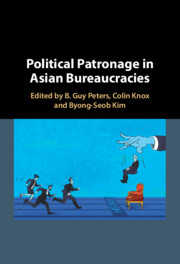Book contents
- Political Patronage in Asian Bureaucracies
- Political Patronage in Asian Bureaucracies
- Copyright page
- Contents
- Figures
- Tables
- Contributors
- Abbreviations
- 1 Patronage in Asian Political Systems
- Part I One-Party Dominated Systems
- 2 Governing the Global City’s Mandarinate
- 3 Patronage and Politicisation in the Indian Administrative Service
- 4 Political Patronage, Civil Service Politicization, and the Ordeals of Career Civil Servants
- Part II Two-Party/Multi-Party Systems
- Part III Autocracies
- Index
- References
3 - Patronage and Politicisation in the Indian Administrative Service
from Part I - One-Party Dominated Systems
Published online by Cambridge University Press: 05 October 2023
- Political Patronage in Asian Bureaucracies
- Political Patronage in Asian Bureaucracies
- Copyright page
- Contents
- Figures
- Tables
- Contributors
- Abbreviations
- 1 Patronage in Asian Political Systems
- Part I One-Party Dominated Systems
- 2 Governing the Global City’s Mandarinate
- 3 Patronage and Politicisation in the Indian Administrative Service
- 4 Political Patronage, Civil Service Politicization, and the Ordeals of Career Civil Servants
- Part II Two-Party/Multi-Party Systems
- Part III Autocracies
- Index
- References
Summary
At the bureaucratic level, Indias administration and policymaking are largely controlled by members of the elite Indian Administrative Service (IAS). Their initial recruitment is on merit and considered fair, and therefore the best brains in the country join the Service at a young age. However, despite their individual competence, IAS officers, who occupy almost all senior administrative positions in the States and Centre, have not been able to improve development outcomes for common citizens. This is largely due to the fact that the political culture in India, at the states level and now since 2014 also at the Central level, is patronage based, and politicians control the civil service to buttress their private gains and ideological goals. This chapter will describe in detail the interface between bureaucrats and politicians, and the methods employed by politicians to manipulate and politicise the civil service. The paper will also describe how politicisation of the senior civil servants has engulfed the entire system after Mr Modi took over as Prime Minister in 2014.
Keywords
- Type
- Chapter
- Information
- Political Patronage in Asian Bureaucracies , pp. 49 - 68Publisher: Cambridge University PressPrint publication year: 2023



